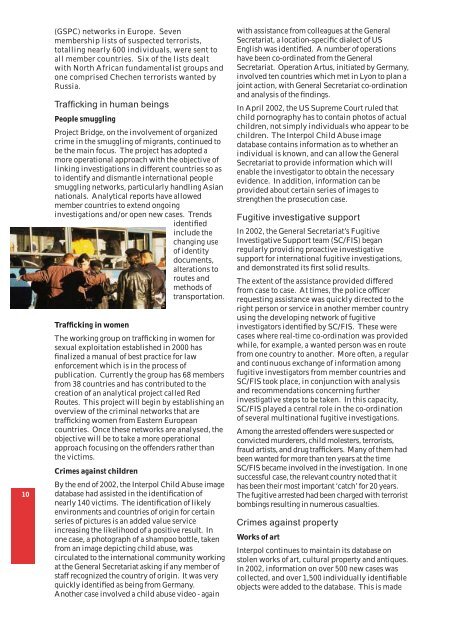Download - Interpol
Download - Interpol
Download - Interpol
You also want an ePaper? Increase the reach of your titles
YUMPU automatically turns print PDFs into web optimized ePapers that Google loves.
10<br />
(GSPC) networks in Europe. Seven<br />
membership lists of suspected terrorists,<br />
totalling nearly 600 individuals, were sent to<br />
all member countries. Six of the lists dealt<br />
with North African fundamentalist groups and<br />
one comprised Chechen terrorists wanted by<br />
Russia.<br />
Trafficking in human beings<br />
People smuggling<br />
Project Bridge, on the involvement of organized<br />
crime in the smuggling of migrants, continued to<br />
be the main focus. The project has adopted a<br />
more operational approach with the objective of<br />
linking investigations in different countries so as<br />
to identify and dismantle international people<br />
smuggling networks, particularly handling Asian<br />
nationals. Analytical reports have allowed<br />
member countries to extend ongoing<br />
investigations and/or open new cases. Trends<br />
identified<br />
include the<br />
changing use<br />
of identity<br />
documents,<br />
alterations to<br />
routes and<br />
methods of<br />
transportation.<br />
Trafficking in women<br />
The working group on trafficking in women for<br />
sexual exploitation established in 2000 has<br />
finalized a manual of best practice for law<br />
enforcement which is in the process of<br />
publication. Currently the group has 68 members<br />
from 38 countries and has contributed to the<br />
creation of an analytical project called Red<br />
Routes. This project will begin by establishing an<br />
overview of the criminal networks that are<br />
trafficking women from Eastern European<br />
countries. Once these networks are analysed, the<br />
objective will be to take a more operational<br />
approach focusing on the offenders rather than<br />
the victims.<br />
Crimes against children<br />
By the end of 2002, the <strong>Interpol</strong> Child Abuse image<br />
database had assisted in the identification of<br />
nearly 140 victims. The identification of likely<br />
environments and countries of origin for certain<br />
series of pictures is an added value service<br />
increasing the likelihood of a positive result. In<br />
one case, a photograph of a shampoo bottle, taken<br />
from an image depicting child abuse, was<br />
circulated to the international community working<br />
at the General Secretariat asking if any member of<br />
staff recognized the country of origin. It was very<br />
quickly identified as being from Germany.<br />
Another case involved a child abuse video - again<br />
with assistance from colleagues at the General<br />
Secretariat, a location-specific dialect of US<br />
English was identified. A number of operations<br />
have been co-ordinated from the General<br />
Secretariat. Operation Artus, initiated by Germany,<br />
involved ten countries which met in Lyon to plan a<br />
joint action, with General Secretariat co-ordination<br />
and analysis of the findings.<br />
In April 2002, the US Supreme Court ruled that<br />
child pornography has to contain photos of actual<br />
children, not simply individuals who appear to be<br />
children. The <strong>Interpol</strong> Child Abuse image<br />
database contains information as to whether an<br />
individual is known, and can allow the General<br />
Secretariat to provide information which will<br />
enable the investigator to obtain the necessary<br />
evidence. In addition, information can be<br />
provided about certain series of images to<br />
strengthen the prosecution case.<br />
Fugitive investigative support<br />
In 2002, the General Secretariat’s Fugitive<br />
Investigative Support team (SC/FIS) began<br />
regularly providing proactive investigative<br />
support for international fugitive investigations,<br />
and demonstrated its first solid results.<br />
The extent of the assistance provided differed<br />
from case to case. At times, the police officer<br />
requesting assistance was quickly directed to the<br />
right person or service in another member country<br />
using the developing network of fugitive<br />
investigators identified by SC/FIS. These were<br />
cases where real-time co-ordination was provided<br />
while, for example, a wanted person was en route<br />
from one country to another. More often, a regular<br />
and continuous exchange of information among<br />
fugitive investigators from member countries and<br />
SC/FIS took place, in conjunction with analysis<br />
and recommendations concerning further<br />
investigative steps to be taken. In this capacity,<br />
SC/FIS played a central role in the co-ordination<br />
of several multinational fugitive investigations.<br />
Among the arrested offenders were suspected or<br />
convicted murderers, child molesters, terrorists,<br />
fraud artists, and drug traffickers. Many of them had<br />
been wanted for more than ten years at the time<br />
SC/FIS became involved in the investigation. In one<br />
successful case, the relevant country noted that it<br />
has been their most important ‘catch’ for 20 years.<br />
The fugitive arrested had been charged with terrorist<br />
bombings resulting in numerous casualties.<br />
Crimes against property<br />
Works of art<br />
<strong>Interpol</strong> continues to maintain its database on<br />
stolen works of art, cultural property and antiques.<br />
In 2002, information on over 500 new cases was<br />
collected, and over 1,500 individually identifiable<br />
objects were added to the database. This is made














